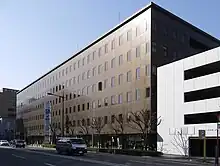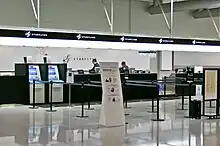StarFlyer
Star Flyer Inc. (株式会社スターフライヤー, Kabushiki-gaisha Sutāfuraiyā), styled as StarFlyer, is a Japanese airline headquartered on the grounds of Kitakyushu Airport in Kokuraminami-ku, Kitakyūshū, Fukuoka Prefecture.[1] It describes itself as a "hybrid airline" providing a higher level of service than low-cost carriers while having operating costs lower than full-service legacy carriers.[2] Although the airline's IATA code is 7G, domestically it has also used the code MQ (which is designated outside Japan by the IATA to Envoy Air) for its flights.[3]
 | |||||||
| |||||||
| Founded | December 17, 2002 | ||||||
|---|---|---|---|---|---|---|---|
| Commenced operations | March 16, 2006 | ||||||
| Operating bases | |||||||
| Frequent-flyer program | Star Link | ||||||
| Fleet size | 11 | ||||||
| Destinations | 8 | ||||||
| Traded as | TYO: 9206 | ||||||
| Headquarters | Kitakyushu Airport Kitakyūshū, Fukuoka Prefecture, Japan | ||||||
| Key people | Makoto Takahashi (Acting President) | ||||||
| Revenue | |||||||
| Net income | |||||||
| Total assets | |||||||
| Total equity | |||||||
| Employees | 824 (June 25, 2020)[1] | ||||||
| Website | starflyer.jp | ||||||
History

StarFlyer was founded as Kobe Airlines (神戸航空, Kōbe Kōkū) on December 17, 2002 with the intention of being based at the new Kobe Airport. The company changed its name to StarFlyer in May 2003, and moved to Kitakyushu at the end of 2003.[4] The airline was founded by former Japan Airlines technician Takaaki Hori and former All Nippon Airways executive Yasushi Muto, who respectively served as president and senior vice president of the company until 2009.[5] Its headquarters were initially in the Shin Kokura Building (新小倉ビル, Shin Kokura Biru) in Kokura Kita-ku, Kitakyūshū;[6] in 2010 the airline announced that the headquarters would move to Kitakyushu Airport.[7]
StarFlyer began service upon the opening of New Kitakyushu Airport on March 16, 2006.[8]
All Nippon Airways (ANA) began an operational relationship with StarFlyer in 2005, allowing StarFlyer to use its computerized reservations system. This relationship expanded to code sharing in 2007, under which StarFlyer service between Haneda and Kitakyushu (and later between Haneda and Fukuoka) was marketed under ANA's airline code. The code sharing immediately boosted StarFlyer's load factors from 59% to over 70%.[8]
In April 2008, the company announced that it would begin charter flights to Seoul in July. The airline said it would evaluate the flights to consider whether to start regular service between the two cities (in the meantime, its call center handled reservations for Jeju Air on this route). In addition, it had also prepared to start charter service to Hong Kong. StarFlyer operated packaged tour charter flights from Kitakyushu to Guam in August 2013 with an aim to provide more "program charter" services in the future.[9]
StarFlyer initially planned an initial public offering (IPO) in fiscal year 2008, but poor financial and operating performance delayed the IPO; among other issues, the airline failed to use appropriate fuel hedging to control its costs, and also had limited ability to raise capital. Hori and Muto resigned from their positions in June 2009, and Shinichi Yonehara, a former Mitsui & Co. aircraft trading executive, became president of the company.[5] Under Yonehara's leadership, the airline completed its IPO on the Tokyo Stock Exchange in December 2011.[4]
The airline suffered a massive cancellation following the 2011 Tōhoku earthquake and tsunami, as 13 of its 29 pilots at the time were non-Japanese, and seven of them were overseas and had refused or were unable to return to Japan.[10]
In December 2012, ANA announced that it had acquired an 18% stake in StarFlyer, making it the largest shareholder in the airline.[11]
In 2013, StarFlyer announced that it would start service between Fukuoka and Kansai International Airport in Osaka, targeting business travelers on a highly competitive city pair where the Sanyo Shinkansen high-speed rail service has a market share of around 80%. StarFlyer announced that it would offer discount fares starting at 4,500 yen to compete with both rail service and the discount airline Peach.[12]
StarFlyer announced a restructuring in November 2013, as part of which it would cut 30 of its employees, suspend its service to Busan effective March 30, 2014, and reduce its fleet from eleven to nine aircraft.[13] StarFlyer was also considering raising fares on its key domestic routes from Haneda to Kitakyushu and Fukuoka.[14]
Three years after its last scheduled international flights to South Korea, StarFlyer in October 2017 announced the relaunch of international services with flights to Taoyuan International Airport in Taiwan from Fukuoka, Kitakyushu, and Nagoya Centrair to begin the following year in October 2018.[15] While the plans for flights between Taiwan and Fukuoka were dropped prior to launch, services between Taiwan and both Kitakyushu and Nagoya Centrair proceeded to begin on October 28, 2018.[16]
During the COVID-19 pandemic that began in March 2020, StarFlyer reduced its operations and suspended its international routes to Taipei, before the airline later cancelled its flights between Kitakyushu and Naha with no plans to resume the services. In December 2022, the airline announced it would be relaunching its international services initially with charter flights between Kitakyushu and Taipei, operating during January and February 2023.[17]
Corporate affairs

As of March 2013, ANA Holdings is the largest shareholder in the company with a 17.96% stake, and several companies that have major operations in the northern Kyushu region are also significant shareholders, including TOTO, Yaskawa Electric Corporation, Kyushu Electric Power Company and Nissan Motor Company.[18]
Kitakyushu Bank has a credit card mileage partnership with StarFlyer.[19] Yamaguchi Financial Group, the parent company of Kitakyushu Bank, made publicized efforts to support StarFlyer's Busan service by approaching businesses, tourism organizations and Japanese expatriate groups in the Busan region.[20]
StarFlyer provides ground handling services for Delta Air Lines at Haneda Airport in Tokyo.[21]
Destinations

StarFlyer has operated a mix of scheduled and chartered flights to the following destinations as of January 2023.
Scheduled
StarFlyer has operated scheduled services to the following destinations:[22][23]
| Country or region | City | Airport | Notes | Refs |
|---|---|---|---|---|
| Japan (Honshū) | Nagoya | Chubu Centrair International Airport | ||
| Osaka | Kansai International Airport | |||
| Tokyo | Haneda Airport | Base | ||
| Ube | Yamaguchi Ube Airport | |||
| Japan (Kyūshū) | Fukuoka | Fukuoka Airport | ||
| Kitakyūshū | Kitakyushu Airport | Base | ||
| Japan (Ryukyu Islands) | Naha | Naha Airport | Terminated | |
| South Korea | Seoul | Incheon International Airport | Terminated | [8] |
| Taiwan | Taipei | Taoyuan International Airport | [15][16] |
Charter
StarFlyer has also operated charter services to the following destinations:
| Country or region | City | Airport | Notes | Refs |
|---|---|---|---|---|
| Guam | Hagåtña | Antonio B. Won Pat International Airport | Terminated | [9] |
| Hong Kong | Hong Kong | Hong Kong International Airport | Terminated | [8] |
| South Korea | Busan | Gimhae International Airport | Terminated | [13] |
| Muan | Muan International Airport | |||
| Taiwan | Taipei | Taoyuan International Airport | [17] | |
Codeshare agreements
StarFlyer has codeshare agreements with the following airlines:
Fleet
.jpg.webp)
The StarFlyer fleet consists of the following aircraft as of June 2023:[26][27]
| Aircraft | In service | Orders | Passengers | Notes | |
|---|---|---|---|---|---|
| Airbus A320-200 | 10 | — | 150 | ||
| Airbus A320neo | 1 | 2 | 162 | Deliveries from 2023. Replacing older aircraft, with options for two additional units.[28] | |
| Total | 11 | 2 | |||
Fleet development
Most of the StarFlyer A320 fleet is leased from GECAS and AWAS,[29] but the airline purchased three A320s to replace older leased aircraft; JA01MC was retired on April 30, 2014 to bring its fleet to a total of ten aircraft, of which five aircraft were to be leased in the future.[30] In October 2020, StarFlyer announced the leasing of up to five A320neo aircraft from SMBC Aviation Capital, with deliveries beginning in January 2023 in order to replace older A320-200 aircraft, and the agreement expected to be completed by February 2021.[28] By December 2022, the airline reported that the expected delivery of its first A320neo in January 2023 was delayed, with the airline subsequently cancelling several flights between January and March 2023.[31] The first A320neo was delivered during June 2023, before entering service on July 4, 2023.[32]
Livery
.jpg.webp)
The company's black and white aircraft livery and corporate branding were designed under the art direction of Tatsuya Matsui, a noted robot designer, in conjunction with SGI Japan. Matsui based the airline's brand identity around the concept of a "Mother Comet" taking passengers through space to their destination. His design work extended to aircraft interiors, airport facilities and in-flight service implements, including the airline's signature leather seats and chocolates.[33]
Additionally, parts of the livery feature inverted color schemes relative to the opposing side of the aircraft. On the aircraft's left-hand side, the vertical stabilizer (tail fin) and wingtip are colored in solid black, with the airline's tail fin logo colored in white. Inversely on the aircraft's right-hand side, the tail fin and wingtip are colored in solid white, with the airline's tail fin logo colored in black.
Cabin and services

StarFlyer's Airbus A320-200 aircraft are equipped with 150 seats in an all economy class cabin layout, offering 34 inches (86 cm) of pitch,[34][8] with its Airbus A320neo aircraft configured with 162 seats. On the A320-200, each seat is equipped with a Panasonic Avionics in-flight entertainment touchscreen system, with older aircraft equipped with a screen offering a range of television or audio channels running on a schedule, and newer aircraft equipped with a larger screen offering audio and video on demand (AVOD).[35] Seats are equipped both with USB ports and traditional electrical sockets for charging devices.[36] Entertainment screens are not equipped on the A320neo, which instead incorporates electronic device holders in place of the screens as well as in-flight Wi-Fi access.[32]
On all flights, the airline offers a traditional refreshment cart service consisting of complimentary and surcharged options.[37] On international flights, the airline offers complimentary meal services.[38] StarFlyer also offers a selection of in-flight shopping goods for purchase, rental services for amenities such as blankets and auxiliary device chargers, as well as services for families with small children.
Frequent-flyer program
StarFlyer's frequent-flyer program is Star Link, a distance-based accrual program through which passengers can earn miles based on the route length of StarFlyer flights.[39]
References
- "会社概要" [Company Profile]. Star Flyer (in Japanese). Retrieved September 13, 2020.
- "Star Flyer steadily expands with niche market positioning". South China Morning Post. October 15, 2018. Retrieved August 27, 2020.
'We've found our niche by providing a higher level of service than budget airlines while offering boutique flights that are priced lower than mega carriers,' says Sadami Matsuishi, president and CEO.
- "StarFlyer Passenger Bulletin" (PDF) (Press release) (in Japanese). Star Flyer Inc. February 6, 2013.
ANA(NH)の記載については、SFJ(MQ)へ読替え願います。
- 沿革 [History]. Star Flyer (in Japanese). Retrieved August 27, 2020.
- スターフライヤーに全日空が「熟柿作戦」 [All Nippon Airways starts operation on StarFlyer]. FACTA (in Japanese). July 2009. Retrieved November 18, 2013.
- "Company Profile". Star Flyer. Archived from the original on February 8, 2008. Retrieved May 26, 2009.
Location - Shin-Kokura Bldg., 2-2-1 Komemachi Kokurakita-ku, Kitakyusyu-shi Fukuoka 802-0003 JPN
- スターフライヤー、北九州空港へ本社移転-業務効率化目指し今秋に [Starflyer moves head office to Kitakyushu Airport-aiming to improve work efficiency this fall] (in Japanese). Hangata Communications. January 4, 2010. Retrieved February 15, 2010.
同社の本社機能についてはかねてより2011年に同空港内への移転計画が伝えられていたが、予定を早めて今年秋に実施することを決めたもの。
- "Japan's StarFlyer looks to expand its successful niche – but change is afoot". CAPA Centre for Aviation. January 24, 2013. Retrieved November 18, 2013.
- Yoshikawa, Tadayuki (August 2, 2013). スターフライヤー、グアムへチャーター便就航 [StarFlyer launches charter flight to Guam]. Aviation Wire (in Japanese). Retrieved August 2, 2013.
- 外国人機長が来日できず、スターフライヤー102便運休 4月 [102 StarFlyer flights cancelled due to foreign captains unable to visit in April]. The Nikkei (in Japanese). March 24, 2011. Retrieved November 18, 2013.
- 全日空、スターフライヤーへの18%出資を発表 [ANA announces 19% stake in StarFlyer]. The Nikkei (in Japanese). December 14, 2012. Retrieved November 18, 2013.
- スターフライヤー、関空―福岡線4500円から 新幹線に対抗 [StarFlyer counters Shinkansen with Kansai-Fukuoka route from 4,500 yen]. The Nikkei (in Japanese). July 31, 2013. Retrieved July 31, 2013.
- Yoshikawa, Tadayuki (November 15, 2013). スターフライヤー、釜山線運休 希望退職など経営合理化 [StarFlyer, Busan line suspension, management rationalization such as voluntary retirement]. Aviation Wire (in Japanese). Retrieved November 18, 2013.
- 石田, 宗久 (November 15, 2013). <スターフライヤー>希望退職者を募集 定期の釜山線運休へ [<Star Flyer> Recruiting voluntary retirees to regular Busan Line suspension]. 毎日新聞 (in Japanese). Archived from the original on November 19, 2013. Retrieved November 18, 2013.
- スターフライヤー、台北線で国際線再参入 [Starflyer re-enters international routes on Taipei route]. The Nikkei (in Japanese). October 27, 2017. Retrieved November 1, 2017.
- Yoshikawa, Tadayuki (October 28, 2018). スターフライヤー、台北便就航 北九州・中部から国際線再参入 [StarFlyer re-enters international flights with launch of Taipei flight from Kitakyushu/Chubu]. Aviation Wire (in Japanese). Retrieved September 13, 2020.
- Liu, Jim (December 9, 2022). "StarFlyer Adds Kitakyushu – Taipei Charters in 1Q23". Aeroroutes.
- "11th AGM Notice" (PDF). StarFlyer. Retrieved November 18, 2013.
- 北九州銀が開業2年 地元密着で預金・融資は順調 [Kitakyushu Bank opened for 2 years, deposits and loans are strong due to local relationships]. The Nikkei (in Japanese). November 7, 2012. Retrieved November 18, 2013.
- 山口FG、スターフライヤー北九州―釜山線の集客支援 [Yamaguchi FG, StarFlyer attracting customers on Kitakyushu-Busan route]. The Nikkei (in Japanese). November 19, 2011. Retrieved November 18, 2013.
- スターフライヤー、デルタのハンドリング業務受託-羽田空港で [Star Flyer, Delta's handling contract service - at Haneda Airport]. FlyTeam (in Japanese). January 2, 2011. Retrieved November 18, 2013.
- "Timetables (Japan Domestic Flights)". Star Flyer. Retrieved August 27, 2020.
- "Timetables (International Flights)". Star Flyer. Retrieved August 27, 2020.
- "StarFlyerCodeshare Flights [Domestic]". All Nippon Airways. Retrieved August 27, 2020.
- "Check-in Procedures". Solaseed Air. Retrieved September 10, 2020.
- "Global Airline Guide 2019 (Part One)". Airliner World (October 2019): 18.
- "Starflyer Fleet Details and History". Planespotters.net. Retrieved October 4, 2019.
- Yoshikawa, Tadayuki (November 4, 2020). スターフライヤー、A320neo導入へ 23年から最大5機 [Star Flyer to introduce up to 5 A320neo aircraft from 2023]. Yahoo! Japan (in Japanese). Retrieved November 6, 2020.
- "AWAS delivers second new A320 to StarFlyer in Japan". Aviation News. March 2013. Retrieved August 27, 2020.
- Yoshikawa, Tadayuki (January 20, 2014). スターフライヤー、13号機が24日到着へ 10機体制に [Star Flyer, No. 13 arrives on 24th, 10 aircraft fleet]. Aviation Wire (in Japanese). Retrieved January 21, 2014.
- Kohase, Yusuke (December 9, 2022). スターフライヤー、A320neo納入遅れで108便欠航 1-3月に羽田-北九州・関西 [Starflyer cancels 108 flights on Kitakyushu-Haneda and Kitakyushu-Kansai routes between January and March due to delayed delivery of A320neo]. Aviation Wire (in Japanese). Retrieved February 8, 2022.
- "A320neo特設ページ" [A320neo special page]. StarFlyer (in Japanese). Retrieved September 23, 2023.
- Watanabe, Hiroshi (May 17, 2005). 「Posy」の松井龍哉氏、エアラインをデザイン - ITmedia LifeStyle [Tatsuya Matsui of "Posy" designs the airline]. ITmedia News (in Japanese). Retrieved April 12, 2014.
- "Aircraft and Seat Map". StarFlyer. Retrieved August 27, 2020.
- "In-Flight Entertainment Services". Star Flyer. Retrieved August 27, 2020.
- "Relaxing Space Design". Star Flyer. Retrieved August 27, 2020.
- "In-Flight Service and Facilities (Japan Domestic Flights)". Star Flyer. Retrieved August 27, 2020.
- "International flights: In-Flight service". Star Flyer. Retrieved August 27, 2020.
- "マイレージ会員 - マイルを貯める・使う" [Mileage Members - Earn and use miles]. Star Flyer (in Japanese). Retrieved August 27, 2020.
External links
![]() Media related to StarFlyer at Wikimedia Commons
Media related to StarFlyer at Wikimedia Commons
- Official website (in Japanese)
- Official website (in English)